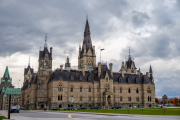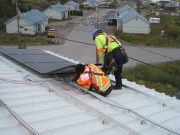When we think about transforming our energy systems, we need to make sure that transformation happens in a way that is not only innovative and capable of meeting society’s need for energy, but also considers the role of women.
As a Western Canadian woman committed to building a new energy economy, my views are shaped by the fact I am a born and bred British Columbian who recently lived in Calgary for six years when I was working as the chief sustainability officer for Enbridge. And now it is a real honour for me to lead the Pembina Institute — a unique Alberta-born Canadian think- and do-tank working on the transition to a net-zero emissions energy future and, perhaps equally important in the pandemic world, a net-zero emissions energy workforce.
 Recently I had the opportunity to join some standout Albertan women — Sheena Wilson, PhD, principal investigator of the University of Alberta’s Just Powers research initiative, Katie Smith, executive director of Alberta-based Young Women in Energy and Nagwan Al-Guneid from the Energy Futures Lab and president of Ask Her YYC — for a discussion about the role of women in this changing energy landscape. In this conversation, and in past experiences, I have found that regardless of career history or geography, the tie that unites almost all of us is a fundamental belief that the world’s energy systems are changing, that the Canadian energy sector needs to be part of that global change, and, in some instances, can even help lead it.
Recently I had the opportunity to join some standout Albertan women — Sheena Wilson, PhD, principal investigator of the University of Alberta’s Just Powers research initiative, Katie Smith, executive director of Alberta-based Young Women in Energy and Nagwan Al-Guneid from the Energy Futures Lab and president of Ask Her YYC — for a discussion about the role of women in this changing energy landscape. In this conversation, and in past experiences, I have found that regardless of career history or geography, the tie that unites almost all of us is a fundamental belief that the world’s energy systems are changing, that the Canadian energy sector needs to be part of that global change, and, in some instances, can even help lead it.
We have already seen an amazing group of women in the medical profession step forward to lead the public health fight against the coronavirus in this country — Dr. Bonnie Henry in B.C., Dr. Deena Hinshaw in Alberta and Dr. Teresa Tam in Ottawa (to name only a few). And an equally amazing and enterprising group of women already have and will continue to step forward to navigate the role that energy innovation and diversification can play on the pathways to net-zero emissions. One of the great strengths of this particular group of women will be their diversity, because they come from both small and large businesses and industries, government, academia, non-profit organizations, and local and Indigenous communities (to name only a few).
At the Pembina Institute, our team of 50 does pretty well on some gender metrics. Our executive and management teams are north of 60% female. But until recently, women made up only 10% of our board — a number we are actively working to improve. With good reason.
According to the International Energy Agency (IEA), women are significantly under-represented in the energy sector. We make up:
- 23 per cent of total employees;
- 20 per cent of board of directors;
- and 18 per cent of management.
I know some Canadian companies and organizations perform a lot better than these averages. But there is still a lot of room for improvement. I mean, really, how are we going to change the world with half the population of the world under-represented?
We all know how hard women work. For our families, our friends, our employers, our teams. According to Diversio (a company that helps organizations achieve diversity and inclusion goals and supports Natural Resources Canada’s Equal by 30 Initiative), the value women bring to the workplace is real and measurable:
- Having women in leadership in the energy sector is associated with an 11 per cent increase in profits;
- Organizations with leadership diversity are 70 per cent more likely to report capturing a new market;
- Companies with gender diverse boards receive significantly higher scores on ESG performance metrics.
That’s just the start of the good business case for parity, but this is about so much more than the bottom line. Because, as the IEA also notes, many studies show that greater gender equality brings even broader economic, social, health and environmental benefits to all. And as a nation, we are coming to grips with some startlingly disproportionate social and economic impacts right now. We are dealing with significant social and economic disparity on the impact of the pandemic on lives and livelihoods. And we have already experienced first-hand some of the disproportionate risk and impact that climate change can have on communities and vulnerable populations that can least afford it.
For all these reasons, the need for greater diversity and inclusion is emerging as a critical component in any strategy for resilience in a world that is going to continue to be subjected to new global shocks and disruptions. It isn’t just women working in energy who have a stake in the transition to a new energy economy. The reality is that today, in Canada and the rest of the world, we all do.






